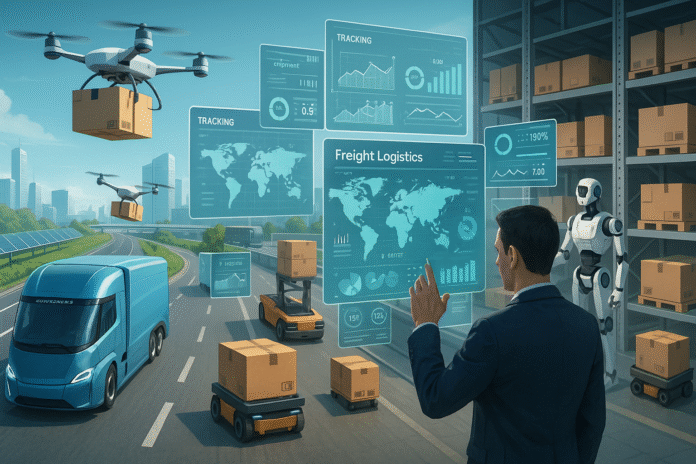The global freight and logistics industry is undergoing a rapid transformation, driven by digital disruption and technological advancements. As we head into 2025, FreightTech—the intersection of freight and technology—is playing a pivotal role in optimizing operations, reducing costs, and enhancing supply chain visibility. From autonomous trucks to AI-driven platforms, innovation is reshaping every link in the logistics chain.
In this blog, we explore the top FreightTech innovations to watch in 2025, how they’re impacting the industry, and what stakeholders must do to stay ahead in this digital age.
1. Autonomous Freight Vehicles
The development and deployment of autonomous trucks and delivery vehicles are accelerating. These driverless solutions are expected to reduce labor costs, minimize human error, and improve efficiency, especially for long-haul routes.
Key Benefits:
- 24/7 operation without driver fatigue
- Lower insurance costs due to fewer accidents
- Enhanced safety through sensors and AI navigation
Example: Companies like TuSimple and Aurora are already testing autonomous freight routes across the US.
2. AI and Machine Learning in Supply Chain Planning
Artificial Intelligence (AI) is revolutionizing freight forecasting, route optimization, and demand planning. Machine learning algorithms process vast datasets in real-time, providing actionable insights that reduce transit delays and inventory shortages.
Use Cases:
- Predictive maintenance of freight equipment
- AI-based dynamic pricing for freight bids
- Intelligent route planning to avoid congested zones
3. Blockchain for Freight Transparency
Transparency is a cornerstone of a trusted supply chain. Blockchain technology ensures tamper-proof, decentralized record-keeping for all shipping transactions, improving documentation integrity and reducing fraud.
Advantages:
- Immutable smart contracts for freight agreements
- Real-time tracking and verification of shipments
- Reduces disputes and streamlines customs clearance
Fact: Maersk and IBM’s TradeLens was one of the pioneering platforms in blockchain logistics.
4. IoT-Powered Smart Containers and Assets
The Internet of Things (IoT) enables real-time tracking of cargo and transport assets. In 2025, smart sensors embedded in containers, trailers, and pallets provide critical data such as temperature, shock, humidity, and location.
Key Innovations:
- Smart reefer containers for cold chain integrity
- Fleet-wide tracking dashboards
- Automated alerts for route deviations or damage
5. Digital Freight Marketplaces
The rise of digital freight platforms is transforming how shippers and carriers connect. These platforms, often dubbed the “Uber for Freight,” eliminate the need for traditional brokers by offering direct, real-time load booking.
Market Leaders:
- Convoy
- Uber Freight
- Loadsmart
Key Features:
- Instant freight quotes
- Real-time truck availability
- Automated payment and documentation
6. Electric and Sustainable Freight Vehicles
With environmental regulations tightening globally, the push for green logistics is stronger than ever. Electric trucks, hydrogen fuel cells, and carbon-neutral shipping solutions are at the forefront of sustainability in FreightTech 2025.
Benefits:
- Reduced emissions and carbon footprint
- Compliance with ESG goals
- Lower fuel and maintenance costs
Example: Tesla Semi and Volvo VNR Electric are expected to scale production in 2025.
7. Warehouse Automation and Robotics
Automation isn’t just on the road—warehouses are becoming smarter too. Robotic pickers, AGVs (Automated Guided Vehicles), and drone inventory systems streamline labor-intensive tasks and improve accuracy.
Technologies in Use:
- Collaborative robots (cobots)
- Automated sorting and packing systems
- Vision-based AI for quality checks
Impact:
- Faster fulfillment cycles
- Lower dependency on manual labor
- Scalability during peak demand
8. Predictive Analytics and Big Data
With data pouring in from various touchpoints, predictive analytics is key to making proactive freight decisions. Platforms now use data visualization, anomaly detection, and risk forecasting to help logistics managers mitigate disruptions before they occur.
Use Cases:
- Port congestion prediction
- Lead time variance alerts
- Fuel cost forecasting
9. 5G-Enabled Freight Operations
5G connectivity is unlocking new possibilities in real-time logistics. Ultra-fast, low-latency communication allows for seamless IoT integration, real-time video monitoring of cargo, and responsive autonomous systems.
Examples:
- High-definition surveillance of high-value goods in transit
- Real-time communication between vehicles and control towers
- Enhanced drone operations for last-mile delivery
10. Cybersecurity in FreightTech
As freight operations become more connected, cybersecurity has become a top priority. The logistics sector is now investing in encrypted platforms, multi-layered firewalls, and AI-driven threat detection systems.
Why It Matters:
- Prevents ransomware attacks on logistics systems
- Protects sensitive cargo and route data
- Ensures business continuity in digital freight networks
What’s Driving FreightTech in 2025?
Several macro-trends are fueling this rapid evolution:
- Labor shortages: Especially in trucking and warehousing.
- Global disruptions: From pandemics to geopolitical tensions.
- Rising consumer expectations: Demand for same-day or next-day deliveries.
- Sustainability mandates: Companies are under pressure to reduce emissions.
These factors are forcing the industry to innovate and adapt faster than ever before.
How Companies Can Prepare
To capitalize on FreightTech in 2025, companies should:
- Invest in training: Equip staff with digital logistics skills.
- Adopt scalable tech: Start with modular, cloud-based systems.
- Build agile teams: Encourage cross-functional teams that adapt to tech quickly.
- Partner with tech startups: Collaborate with FreightTech innovators for pilot programs.
- Audit your tech stack: Evaluate legacy systems that might hinder digital transformation.
Final Thoughts
FreightTech is not a future concept—it’s here, evolving rapidly, and reshaping logistics as we know it. In 2025, companies that embrace automation, connectivity, sustainability, and data intelligence will lead the freight revolution. Whether you’re a shipper, carrier, 3PL, or tech provider, understanding and integrating these innovations is essential for future-proofing your logistics strategy.


